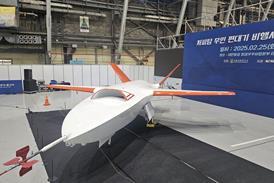The next generation of large airliners captured the show headlines.
Andrew Doyle/LONDON
DESPITE THE FACT that Boeing, as expected, failed in its last-ditch efforts to launch its 747 major derivatives at the 1996 Farnborough air show, the civil spotlight was firmly focused on the next generation of "super-jumbos" and the engines which are being developed to power them.
As the dust settles, and with Boeing seeking launch customers for the 747-500/600X, a small number of airline executives with huge amounts of money to spend are left facing some tough decisions, probably the toughest they will be asked to make in their careers.
Although Boeing appears to have taken the early initiative, promising a service-entry date for the 747-600X as early as 2000, there is some evidence that the US giant is, at least behind closed doors, taking the Airbus threat seriously.
So seriously does it take it, in fact, that it decided to unveil at Farnborough the configuration of a 650-seat "-700X" variant, for which it claims not to have identified a market yet. The -700X, which has the new wing, engines, systems and undercarriage of the -500/600X, but with a new, ultra-high-capacity fuselage, is aimed at reassuring at least one customer in particular which is expressing serious interest in the capabilities of the stretched A3XX-200.
It can be argued that most potential super-jumbo customers, at least on paper, would like to buy the A3XX. As an all-new design, it will have up to 10% lower operating costs than the 747-500X/600X, says Airbus.
It will have a wider fuselage, a full-length upper deck with twin aisles, and the entire cabin will be designed from scratch, enhancing passenger comfort. The stretched A3XX-200 with 656 seats in three classes will be just 77.4m long (compared with 85m for the 548-seat 747-600X) - a major consideration for the majority of customers which face severe space constraints at the airports they serve.
The problem for airlines is that, if they decide to wait for the A3XX to become available, they will forfeit the benefits, which can be derived from being a launch customer for the 747 major derivatives. They could also have to wait at least an extra three years to take delivery of the aircraft, as service entry is planned for mid-2003.
The aircraft will not even be offered formally to airlines until late 1998. Many of the potential customers could use the 747-500X/600X as soon as it becomes available in 2000, and Boeing is already accepting commitments. There now seems little doubt that a formal launch will be made before the end of the year, possibly by November.
Another critical factor for Airbus will be to learn to what extent Boeing manages to pre-empt the market for 500-plus-seaters, bearing in mind that it is coming to the market three years earlier than the European consortium's offering. If Boeing can sign the majority of key customers with its re-winged 747 derivatives before the A3XX is offered, Airbus' decision to enter the market could be made that much more difficult.
Questions also remain over how much it will cost to develop the A3XX, who will finance it and, indeed, whether there is a large enough market to justify this expenditure. All of this does little to reassure the airlines being offered the chance to sign on Boeing's dotted line that Airbus will come up with an alternative.
A public row over development costs and potential market sizes for aircraft with more than 500 seats erupted at Farnborough, following Boeing's assertion that a brand-new aircraft would cost $12-15 billion to develop, with a potential market for just 500 aircraft over the next 20 years. These figures are based on the abandoned Very Large Commercial Transport study carried out jointly by Boeing and the Airbus partner companies.
Ron Woodard, president of the Boeing Commercial Airplane Group, attempts to reinforce the company's conservative outlook on market size by offering a historical perspective.
"Since the first 747 went into service in January 1970, we've produced slightly more than 1,000 aircraft, and only about half of those operate as passenger aircraft on long-haul routes," says Woodard. In other words, after 26 years of 747 production, only slightly more than 500 aircraft with more than 400 seats are being operated on scheduled long-haul routes.
Airbus, meanwhile, believes that it can develop the A3XX for around $8 billion, catering for a total available market of 1,380 aircraft over 20 years. Development costs for the 747-500/600X are estimated by Boeing at $5 billion.
The Airbus partners have already indicated that they will not sanction a formal launch of the A3XX without a sound business case for doing so. An additional complication is the planned restructuring of the Airbus consortium into a commercial company, possibly by the year 2000.
In effect, the airlines do not have any guarantee that Airbus will "-come up with the goods", as one airline source puts it. The A3XX is the higher-risk option that could be exactly what the airlines want, but they have yet to be convinced that it is a deliverable product.
Source: Flight International























